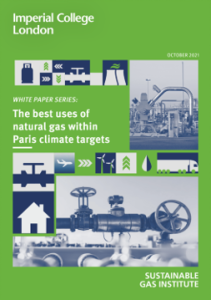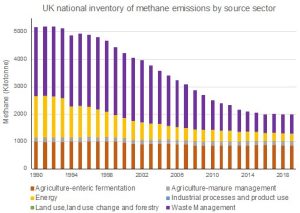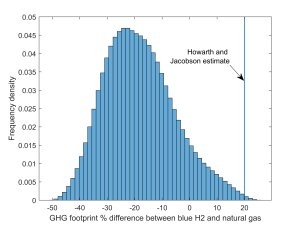 Leonie Marie Emilie Orhan is a student on the MSc Sustainable Energy Futures course at Imperial College. She previously did her undergraduate at the University of Warwick in Mechanical Engineering. Leonie wrote a summary blog post about the latest white paper, ‘Best uses of natural gas within climate targets’ and launch event.
Leonie Marie Emilie Orhan is a student on the MSc Sustainable Energy Futures course at Imperial College. She previously did her undergraduate at the University of Warwick in Mechanical Engineering. Leonie wrote a summary blog post about the latest white paper, ‘Best uses of natural gas within climate targets’ and launch event.
The sixth white paper from the Sustainable Gas Institute ‘Best uses of natural gas within climate targets’ focuses on the future uses of natural gas within the 1.5°C Paris climate targets for both 2050 and 2100. Through the analysis of different gas use scenarios (and energy mixes) from the Intergovernmental Panel on Climate Change (IPCC), it highlights the uncertainties in the future use of natural gas and highlights the potentials of Carbon Capturing and Storage (CCS) and of hydrogen in decarbonisation. It also focuses on the impact policies have on the development and growth of these industries through investment attractivity.
The presentation (watch the launch video) was hosted by the author, Dr Jamie Speirs, a Research Fellow at the Sustainable Gas Institute and the Centre for Environmental Policy, and co-authors, Luke Dubey, a Research Assistant at the Sustainable Gas Institute, and Naveed Tariq, a PhD Researcher from the Department of Chemical Engineering at Imperial College London.
Gas use differs across regions

It is evident that natural gas usage must be reduced not only to attain the 1.5°C targets, but also to conserve fossil fuel reserves for applications which do not yet have viable substitutions. A large majority of the scenarios agree with this, with large variations in different regions. The report shows that Europe’s consumption is set to drop rapidly through substitutions to greener solutions, while in Asia, natural gas would increase until 2050 (before decreasing) due to a growing middle class which relies on affordable energies. I found that highlighting these differences brought light to the individuality of solutions required if they are to consider not only the environmental perspective, but also the social and economic facets.
The importance of carbon capture and storage
Natural gas use was also shown to decrease significantly faster without carbon capture and storage (CCS) than with CCS. This demonstrates that to meet the 1.5°C targets while allowing a more significant transition period to other more sustainable energies, CCS must develop quickly. However, CCS development is controlled by economic incentives and policies as these are needed to be in place to draw in investments to enable the growth of the CCS industry.
Natural gas and hydrogen
In sectors for which decarbonisation is more difficult, such as domestic heating or transport, hydrogen could provide a substitute for the use of natural gas. Currently, hydrogen can be separated into blue and green hydrogen: blue hydrogen is produced using natural gas and green hydrogen using renewable energies. Due to the high costs of green hydrogen production, blue hydrogen is currently more favourable to the economy. Although its production does contribute to greenhouse gas emissions, its growth is necessary to pave the way for green hydrogen. This is due to the infrastructure needs of hydrogen production, storage, and distribution.
The UK government has stated in its recent Hydrogen strategy that both CCS and hydrogen will be essential to decarbonisations with notable milestones based on an increase in hydrogen production (1GW by 2025 and 5GW by 2030), an increase in CCUS clusters (2 by 2025 and 4 by 2030) and hydrogen heating and hydrogen town trials in 2025 and 2030. This shows a\strong interest from the government in these economies, as the UK seeks to transition quickly to enable a strong economic growth.
The White Paper points out that the scenarios analysed are based on the current knowledge of greenhouse gas emissions, which lacks an understanding of methane global warming potentials and may be affected by other factors in the future. This points out the need for a regular analysis and updated predictions and shows that there could be discrepancies between the scenarios presented and the future.
One of the main points I feel was conveyed in the report and presentation was the lack of policies to incentivise the growth of CCS and hydrogen production, which have the potential to play large roles in reaching the 1.5°C targets. Policies would need to centre around the development of the infrastructures required, the realignment market regulations to meet the demands of CCS and hydrogen, and agreements for international trade of hydrogen.The differences in hydrogen demand depending on how strong policies were really illustrated these points, with few and weak policies resulting in a demand over three times smaller than for strong ones, while with policies whose strengths and numbers are at a theoretical maximum, the demand came close to twice that of strong policies.
Expert views on the report
Dr Susana Moreira, a Senior Gas Specialist at The World Bank, offered a commentary which outlined the importance of investing in more electricity grids to cope with the demand and ease the changes in economy required to pave the way to a net zero future. Another pertinent point was that of connecting everyone to the grid and the adjustment that gas producing countries would have to make, not only to their electricity structures, but also to their economies. The impact of hydrogen production to the environment and communities was also pointed out. Overall, her commentary brought light on economic, social, and environmental issues which are key factors in the consideration of a net zero future.
Martin Lambert, a Senior Research Fellow at the Oxford Institute for Energy Studies, focused his commentary on emphasising the need of investments and policies required to do so.
Overall, the paper shows that to meet the 1.5°C targets, CCS and hydrogen must benefit from policies to encourage investments and regulations to direct the market as meeting the targets requires reliance on CCS and hydrogen. I feel more emphasis should have been placed on the idea that although the population is projected to increase to over 10 billion by 2100 (UN Population Facts, December 2019) natural gas usage is predicted to decline.


